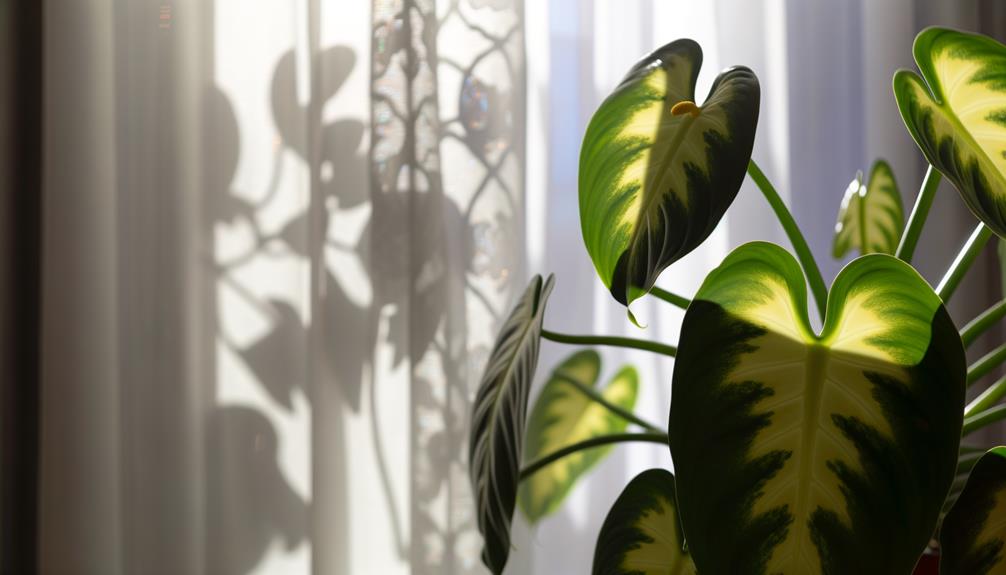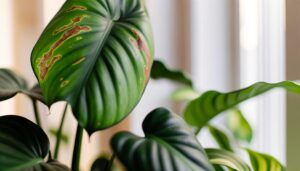What Does a Mature Philodendron Brasil Look Like?
A mature Philodendron hederaceum var. oxycardium 'Brasil' presents heart-shaped leaves, typically 6 to 8 inches long, with a smooth, glossy surface and entire margins.
The foliage features striking variegation, with bright chartreuse and deep emerald green hues, and a cream-colored central region bordered by irregular green margins. This plant, reaching 30 to 60 centimeters in height, showcases a vining growth habit supported by aerial roots.
It thrives under moderate to bright indirect light while requiring support structures due to its extensive vining nature. The plant's robust root system and indeterminate growth pattern guarantee resilient and extensive coverage.
Discover more nuanced aspects of its cultivation and care.

Key Takeaways
- Heart-shaped leaves, 6 to 8 inches long, with glossy surfaces and variegated green and chartreuse patterns.
- Vining growth habit with aerial roots and bifurcating stems for bushy foliage.
- Reaches a height of 30 to 60 centimeters with a semi-erect posture.
- Adaptable to various lighting conditions but thrives in moderate to bright indirect sunlight.
- Compact growth with shorter internodes, requiring support structures for extensive coverage.
Leaf Size

The leaf size of the mature Philodendron hederaceum var. oxycardium 'Brasil' typically ranges from 6 to 8 inches in length. These leaves are distinctively cordate, reflecting a heart-shaped morphology characteristic of the species.
The lamina is generally smooth with a slightly glossy surface, enhancing its visual appeal. Margins are entire, contributing to a uniform and clean edge. The petiole, which supports the leaf blade, is robust, allowing the foliage to maintain a semi-erect posture.
It's worth mentioning that the leaf size and form are influenced by environmental factors such as light intensity and humidity levels. Adequate care involving ideal conditions ensures the foliage achieves its full potential dimensions, indicative of a healthy specimen.
Color Patterns
The mature Philodendron hederaceum 'Brasil' exhibits a striking array of variegation, characterized by its unique intermingling of chlorophyll-deficient and chlorophyll-rich regions on the leaves. This variegation results in a visual mosaic of bright chartreuse and deep emerald green.
Additionally, the stems and veins often display hues ranging from light green to reddish-brown, contributing to the plant's distinctive aesthetic.
Variegation and Leaf Colors
Variegation in Philodendron hederaceum 'Brasil' manifests as striking patterns of green and cream, attributable to chlorophyll distribution and genetic mutation. The variegation occurs due to sectors of chlorophyll-deficient tissue alongside normally pigmented areas, resulting in a mosaic of vibrant and muted hues.
Typically, the central region of each leaf is cream-colored, bordered by irregular green margins. The chlorophyll concentration in the green areas provides the typical photosynthetic capability, while the cream sections display a lack of chlorophyll, causing the lighter coloration.
This variegation pattern is not only visually appealing but also indicative of the plant's genetic stability, as consistent variegation is often a sign of a well-established cultivar. The interplay of these colors enhances the ornamental value of Philodendron 'Brasil'.
Stem and Vein Hues
In Philodendron hederaceum 'Brasil', stem and vein hues display a complex interplay of green and yellow-green tones, contributing to the plant's intricate aesthetic appeal. The stems typically present a vibrant green coloration, occasionally interspersed with lighter, almost lime-green sections.
Veins, in contrast, often appear as a lighter green or yellow-green, creating a striking visual differentiation against the darker leaf blades. This chromatic variation not only enhances the ornamental value of the plant but also indicates its health and essentiality.
The precise pigmentation can be influenced by environmental factors such as light intensity and nutrient availability, making it crucial to maintain ideal growing conditions for the best expression of these distinctive hues.
Leaf Texture

Philodendron hederaceum 'Brasil' showcases a distinct leaf texture characterized by its smooth, shiny surface and slightly wavy margins.
The upper surface of the leaf is noticeably lustrous, reflecting light and enhancing its visual appeal in ambient lighting conditions.
The lower surface, while less reflective, maintains a consistent texture. The leaves are leathery, contributing to their durability and resistance to physical damage.
Marginal undulations provide a subtle waviness that adds to the plant's aesthetic complexity.
Moreover, the leaves are frequently variegated with irregular, cream-colored streaks along the midrib, contrasting against the predominant green.
This variegation does not affect the texture but enhances the visual perception of depth and dimension within the foliage.
Plant Height
Philodendron hederaceum 'Brasil' typically exhibits a growth range between 30 to 60 centimeters in height under ideal conditions.
Factors such as light intensity, soil composition, and ambient humidity greatly influence the plant's vertical development.
Understanding these variables is essential for cultivating a robust and healthy specimen.
Typical Growth Range
Typically, the Philodendron hederaceum var. oxycardium 'Brasil' can reach a height ranging from 30 to 60 centimeters under ideal indoor conditions. This growth range depends on the provision of optimal care, including sufficient light, appropriate watering, and suitable humidity levels.
The 'Brasil' variety shows a vining growth habit, often requiring staking or support structures to manage its upward and outward expansion. It is worth noting that, while the primary stem can reach the mentioned height, the overall spread of the plant, including its trailing vines, can extend significantly beyond this range.
As a result, the Philodendron 'Brasil' not only functions as a compact vertical element but also as an expansive, cascading feature in interior plant arrangements.
Factors Affecting Height
The height of Philodendron hederaceum var. oxycardium 'Brasil' is influenced by several factors, including light intensity, watering frequency, nutrient availability, and ambient humidity levels. Best light conditions involve bright, indirect light, which promotes vertical growth without causing photodamage.
Watering frequency must strike a balance; overwatering can lead to root rot, while underwatering hinders growth. Macronutrients, particularly nitrogen, phosphorus, and potassium, are essential for robust stem elongation and foliar development. Nutrient deficiencies can stunt growth or cause chlorosis.
Additionally, ambient humidity levels of 60-70% are optimal, as low humidity can cause desiccation and reduced growth rates. By managing these variables, one can enhance the height and overall health of Philodendron 'Brasil'.
Growth Habit

Exhibiting a vining growth habit, Philodendron hederaceum 'Brasil' utilizes aerial roots for attachment and support as it climbs or trails. These roots allow the plant to adhere to various surfaces, enabling vertical or horizontal growth. The plant's indeterminate growth pattern facilitates extensive coverage, making it ideal for hanging baskets, trellises, or moss poles. Adaptable to diverse environments, Philodendron 'Brasil' can thrive in both low-light and bright, indirect light conditions.
| Growth Aspect | Description |
|---|---|
| Growth Pattern | Indeterminate, vining |
| Support Mechanism | Aerial roots |
| Suitable Growth Surfaces | Trellises, moss poles, hanging baskets |
This species' versatile growth habit contributes to its popularity in ornamental horticulture, offering both aesthetic appeal and functional adaptability.
Stem Characteristics
The stem characteristics of *Philodendron hederaceum* var. *oxycardium* 'Brasil' exhibit distinct growth patterns, including climbing and trailing tendencies.
The stems feature prominent nodes and internodes, vital for the plant's vining habit and asexual reproduction.
Understanding the morphological details of these structures is essential for effective propagation and overall plant health management.
Stem Growth Patterns
Philodendron hederaceum 'Brasil' displays distinct stem growth patterns characterized by internodal elongation and robust climbing tendencies. The plant uses adventitious roots to anchor itself to surrounding structures, aiding in vertical and horizontal expansion.
Stems exhibit a semi-woody texture as they mature, providing structural support to the plant. The climbing behavior is influenced by positive phototropism, guiding the stems towards light sources. This species also shows a preference for sympodial growth, where stems bifurcate, promoting bushier foliage.
The stems are green with a slight sheen, enhancing their visual appeal. In ideal conditions, the growth rate is vigorous, allowing rapid colonization of available space. Understanding these growth patterns is essential for effective cultivation and spatial planning in both domestic and botanical settings.
Node and Internode Details
Nodes and internodes of Philodendron hederaceum 'Brasil' exhibit significant differentiation, with nodes serving as critical junctions for leaf attachment, adventitious root formation, and potential aerial root development.
Nodes are characterized by their swollen appearance, providing structural integrity and facilitating nutrient transport. Internodes, the stem segments between nodes, vary in length depending on environmental conditions and plant age. Shorter internodes typically indicate a more compact growth habit, while longer internodes suggest etiolation due to insufficient light.
Each node has the capacity to produce new growth, making them essential for vegetative propagation. Philodendron hederaceum 'Brasil' often displays prominent internodal length in mature specimens, contributing to its trailing or climbing nature. Understanding these characteristics is pivotal for effective cultivation and propagation.
Root System

A robust and extensive root system characterizes Philodendron hederaceum 'Brasil', enabling efficient nutrient and water uptake. The root architecture includes both aerial and subterranean roots, the former anchoring the plant to vertical surfaces while the latter secures it in the soil. These roots exhibit high plasticity, adapting to various environmental conditions and substrates.
The following table summarizes key characteristics of the root system:
| Root Type | Function | Adaptability |
|---|---|---|
| Aerial Roots | Anchoring and support | High |
| Subterranean Roots | Nutrient absorption | Moderate |
| Fibrous Roots | Water uptake | High |
This sophisticated root system is integral to the plant's overall health, ensuring sustained growth and resilience against environmental stressors.
Flowering
Flowering in Philodendron hederaceum 'Brasil' is a rare occurrence, typically occurring under ideal environmental conditions and indicating a mature phase of the plant's lifecycle.
The inflorescence comprises a spadix, which is enveloped by a spathe, characteristic of the Araceae family. This spadix is composed of numerous tiny flowers, which are often inconspicuous.
Flowering is generally induced by specific photoperiods and favorable humidity levels, alongside a stable temperature range. Successful flowering can be indicative of a well-established root system and sufficient nutrient availability.
While the flowers themselves are not particularly decorative, their presence underscores the plant's overall health and maturity. It is worth mentioning that propagation is usually achieved through vegetative means, as the flowers seldom produce viable seeds.
Light Requirements

Philodendron hederaceum 'Brasil' requires moderate to bright indirect sunlight to maintain its vivid variegation and overall health. Exposure to insufficient light will lead to reduced chlorophyll production, resulting in decreased color contrast and potential etiolation. On the other hand, direct sunlight may burn the leaves, causing irreversible damage. The ideal light spectrum for this species is filtered sunlight, ideally achieved through sheer curtains or placement near north or east-facing windows.
| Light Intensity | Impact on Plant Health |
|---|---|
| Low Light | Faded variegation, spindly growth |
| Moderate Indirect | Optimal variegation, robust foliage |
| Bright Indirect | Improved growth, vivid coloration |
| Direct Sunlight | Leaf burning, browned edges |
| Artificial Grow Light | Supplemental light for insufficient natural light |
This light balance guarantees a flourishing, visually appealing Philodendron hederaceum 'Brasil'.
Common Issues
Common problems encountered with Philodendron hederaceum 'Brasil' often include chlorosis, pest infestations, and root rot due to improper care practices.
Chlorosis, characterized by yellowing leaves, typically results from nutrient deficiencies, specifically iron or magnesium, or inadequate light exposure.
Pest infestations such as those caused by aphids (Aphidoidea), spider mites (Tetranychidae), and mealybugs (Pseudococcidae) can lead to significant foliar damage and stunted growth.
Root rot is frequently induced by overwatering or poor soil drainage, which creates anaerobic conditions favorable to pathogenic fungi like Pythium and Phytophthora.
Addressing these issues requires appropriate fertilization, vigilant pest control, and ensuring ideal watering practices. Regular monitoring and timely interventions are essential to maintain the health and aesthetically pleasing appearance of Philodendron hederaceum 'Brasil'.
Conclusion
The mature Philodendron hederaceum 'Brasil' exhibits large, variegated leaves with intricate color patterns and a glossy texture. Achieving heights of several feet, its climbing growth habit necessitates structural support.
The extensive root system underpins its vigorous growth, while flowering remains a rarity. Best development occurs under bright, indirect light.
Common issues include pests and root rot. How can these characteristics be manipulated to enhance indoor cultivation? Understanding these traits is essential for successful propagation and maintenance.






